Monday 5.19
10:50PM
My Red Sox hating went well (sarcasm.) John Lester, who conquered lymphoma in 2006 and made it back to the majors, pitched a no-hitter against Kansas City tonight. My friends invited me back anytime. The city is abuzz outside.
. . . . . . . . . . . . . . . . . . . . . . . . . . . . . . . . . . . . . . . . . . . . .
7pm
Whiskey’s Food & Spirits
885 Boylston St
Boston, MA 02116
Literally walk out the door of the convention center at the far end past the escalators, Whiskey’s is right across the street.
There’s no more conference programming tonight, so I’m meeting a bunch of my Boston buddies for .10 cents wings and libations, and a little game we like to play called credit card roulette. I’ll probably leave the laptop in the bag, or face merciless mocking from my college friends who are professional taunters. They will be rooting for the Sox, who will begin losing badly on multiple 40” lcd screens to the Royals at 7:05pm. Being the Yankee homer that I am, I’ll be toasting to Bucky Dent and Aaron Boone, and will probably get escorted out on Boylston Street by management against my will before 10pm… If you find me in the bar, I’ll buy you a drink (assuming, of course, you are willing to pledge a life oath to the NY Yankees.)
. . . . . . . . . . . . . . . . . . . . . . . . . . . . . . . . . . . . . . . . . . . . .
7 questions with Stefan Bucher
… . .
Doug Bartow: Stefan, you’re a formally trained designer, you’ve worked in advertising, authored books on design, now you’ve written and designed a book based upon your illustrations. How do you define yourself creatively?
Stefan Bucher: Needlessly complex and virtuously ambitious. I think there’s an easier way of doing this work, I just haven’t figured out what it is yet. I do all this at the same time just to entertain myself, and keep myself entertained.
… . .
DB: 100 Days Of Monsters is an online project cleverly turned into a hardcover book. What were the challenges involved with porting the original online media, such as videos of the drawings and user’s blog texts to a traditional linear book format?
SB: That was the big challenge, because you have a website and blog that are alive. There’s something new every day, and people post responses to that. The living, breathing part of it is beautiful. The solution I designed uses a time stamp on every page which records when I did the drawing as well as when the blog stories were posted.
… . .
DB: The “Meet Your Monster” dvd included in the back of the book covers all the online content from your blog for monsters 1-100 as well as bonus material like open source monsters so readers can draw their own. Do you think the dvd (rich media) is a better representation of the project than the actual book itself?
SB: I think both play together. The book allows you to actually see the drawings as ink on paper for the first time, because the online versions were very small and distorted by the lens. Being able to read the stories in book format is more pleasurable as well. We reformatted the dvd to improve the quality of the videos.
… . .
DB: What advice would you give to designers who have interesting personal projects that they’d like to get published?
SB: Do it! If you do enough of it, you can show someone how it would work. I got very lucky with HOW, who were nice enough to take a chance on this. I talked to a couple of other publishers who wanted to change it, and that’s not what I’m interested in. HOW was great because they published it the way it is. If they had said no, I would have taken out a loan and published it myself.
… . .
DB: What’s one thing that most people don’t know about Stefan Bucher?
SB: How much tape do you have? Ha!
I’m really shy, but nobody believes it. Did you see the movie The Secretary with James Spader and Maggie Gyllenhaal? There’s a scene where he tells her, “I’m shy, but I’ve overcome it.” I’m also lazy, but I’ve overcome that! I think I work so much because I feel guilty, and could be doing more. When I get to the point when I have a month free, it’s a mess and I can’t get anything done. But, when I get 10 projects going at the same time, I get a ton done because I’ve got momentum, and if I get bored with one project, I can steal some time and move on to the next.
… . .
DB: My 8-year-old son, who loves to draw and also loves plush toys, would like to know if any of the monsters will be available at his local toy store anytime soon?
SB: Wouldn’t that be great? If there’s anyone out there that is interested in that, please email me. That’s how this project started to begin with…
… . .
DB: Finally, in the end notes of the book, you thank your “excellent shrink.” Does it take a certain level of insanity to be successful in today’s design world?
SB: It takes a certain level of insanity to be successful in life. For me, it’s “how do I get through the day without being bored?” I do think it’s important to be a little bit crazy, because it only means you see things a little bit differently than other people see them. It’s very much like the study done a few years ago between artists and schizophrenics. They both hear voices, but only the artists realize that those voices are your inspiration.
… . .
DB: Thanks, Stefan.
. . . . . . . . . . . . . . . . . . . . . . . . . . . . . . . . . . . . . . . . . . . . .
5pm
Resource Center Happy Hour
Sounds like drinks in the copy room…apparently the Academy of Art University and Shutterstock booths will be giving out 100 free drink tickets. Let me do the math on that one: 4000 people…100 free drinks available. I don’t like my odds here. Cash bar here I come.
. . . . . . . . . . . . . . . . . . . . . . . . . . . . . . . . . . . . . . . . . . . . .
3:45pm
When Good Prospects Become Bad Clients
Speaker: Shel Perkins
President
Shel Perkins & Associates
Berkeley, CA
National Board Member, AIGA
How speaker link
How session link
Shel Perkins’s www site
Shel Perkins’s book
From the session description:
Design management expert Shel Perkins will discuss the skills and procedures necessary for launching and maintaining great relationships, including when and how to say no. You’ll learn how to: evaluate and screen prospective clients, structure each new relationship for success by establishing ground rules, manage client expectations (push back when necessary.)
Sounds incredibly useful for me. As a small design firm co-owner, screening prospects and structuring good working relationships with clients right from start is critical to efficiency. Efficiency is critical to being profitable. Profitability is critical to making payroll, etc…
You can view the entire list of sessions for this conference by time slot or by session. The ‘session view’ sorts out each presentation by theme, such as: business and management, career development, creativity and inspiration, design disciplines, technology and production, ‘in-Howse’ issues, etc… When you view by category, the method to How’s madness of programming makes sense: offer a little somethin’-somethin’ for everyone, make the time slots work, and let the participants pick and choose what they want to attend. Not groundbreaking, but it needn’t be.
Shel has taken the podium and is speaking to the client/designer relationship, and how designers who don’t set ground rules up front with their clients will be in trouble later in the project.
Topics:
#1: Position yourself as the expert
You need to specialize and communicate that area of specialization to your clients. Then, win awards, document them, send press releases.
#2: Carefully screen all prospects
What is the criteria for the perfect project. Make sure new projects meet your credentials and technical capabilities. Make sure any new clients are within your target industries. Be a reputable company, and offer some potential for long term relationship development. Ramp up for what you think will become a long term relationship, and you will form a long term relationship. Is the budget and schedule realistic? Turn down projects that are not a match, they are doomed for failure.
#3: Structure the relationship for success
Establish ground rules and get a signed contract that spells out details.
#4: Manage client expectations
Provide the right level of project information and documentation. Carefully manage scope creep and change orders to budget for that. Be diligent about that to protect your profit margin.
#5: Strengthen your people skills
Many young designers are talented, but don’t have the interpersonal skills to sell their design. Be an active listener.
Note: this room is too dark to get a good picture. Imagine Shel Perkins standing on a stage at the end of a ballroom speaking to a large powerpoint screen. You got it.
#6: Become a trusted adviser
Function at a highly professional level. Get involved at the strategy level.
Resources that Shel suggests:
AIGA Center for Practice Management.
(He’s the driving force behind this initiative.)
The AIGA Standard Form of Agreement for Design Services
Shel’s book Talent is Not Enough
Shel is now taking audience questions. He’s very easy going, and really knows the nuances of the designer/client relationships, and how to avoid the pitfalls that can degrade design work and business relationships.
. . . . . . . . . . . . . . . . . . . . . . . . . . . . . . . . . . . . . . . . . . . . .
2pm
Arriving at Creativity
Speakers: Stefan Bucher & John Foster
Stefan Bucher
Principal
344design
Pasadena, CA
John Foster
Vice President, creative
fuszion
Alexandria, VA
How speaker link (Stefan Bucher)
How speaker link (John Foster)
How session link
Stefan Bucher’s blog (Stefan Bucher’s Daily Monster)
Stefan Bucher’s www site
Stefan Bucher wiki
John Foster’s www site
John Foster’s book
Stefan Bucher’s books:
100 Days Of Monsters, All Access: The Making of Thirty Extraordinary Graphic Designers.
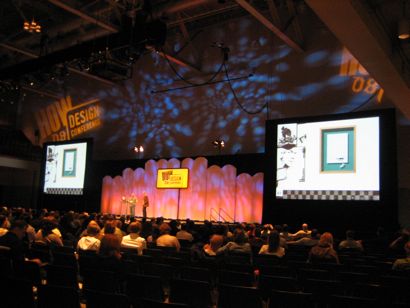
Stefan Bucher (pronounced BOOQ-er) is tall. John Foster, not so much. John started us off with a fun homemade video from Fuszion and made a pretty nice point about just being one of ten representing his shop here at the conference. They are sharing the podium in a very informal manner, and talking about the dream of beginning a project with just a white sheet of paper and the endless possibilities that might present.
I’ve made the mistake of siting next to a tower of speakers, so I can hear Stefan and John breathing, in a weird Darth Vader kind of way.

Stefan made the point that when Lindsay Lohan screws up, the whole world knows about it… but no one sees our design mistakes. John is describing how his design process runs concurrent with his iCal. As soon as they started the talk, John’s alarm popped up to remind him of this 2pm lecture. Apparently, it is working.
They are going back and forth on how their own creativity happens: John keeps his mind in a creative mode as much as possible, regardless of the task. Stefan called his technique ‘cheating’ or procrastinating on one project in lieu of another. The point they are making is you need to be ready to create when you have the opportunity. Time at the office = production time, but ideas come at the weirdest times, like when you get up and walk to the store, for example. I think we all know how serendipitous idea creation can be.
John is showing some work he did on the side for a friend’s shoe store called Shake Your Booty while he was working in a corporate environment from 9-5. The ads are hand-drawn and John came up with the idea of changing the bi-annual sale to “big ass sale.” They are rough, funny and evocative. He went on to say that he got some great interviews in town as a result of all the agencies recognizing the pro-bono work he did on the side for a friend. Everyone knows someone who is starting some type of business, their point is to seek out those opportunities, regardless of fee, and let your creativity out.
Stefan ended with a special monster illustration video for the conference, which made the leap from the drawing board to an illustrated concert stage with a little help from Tom Jones’ It’s Not Unusual…
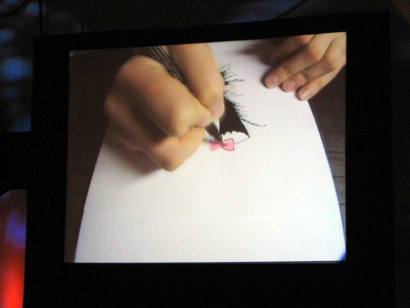
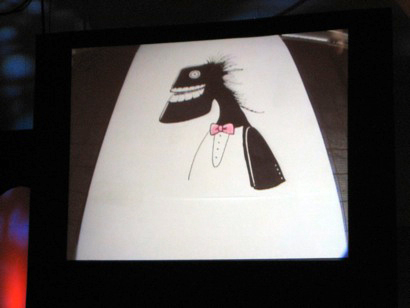
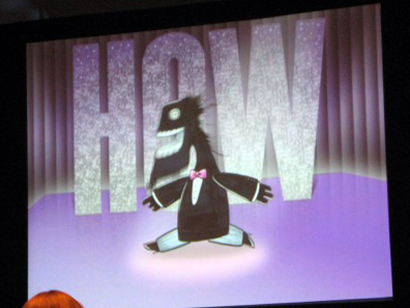
I’ve arranged a quick interview later with Stefan Bucher at his book signing, and I will ask him some detailed questions about his book. Can he make a Daily Monster on the spot out of some condiment packets and plastic utensils I stole from the lunch room? Let’s find out…
If you’d like to ask Stefan Bucher a specific question, make it good, and email it to me asap…I’ll publish it later.
. . . . . . . . . . . . . . . . . . . . . . . . . . . . . . . . . . . . . . . . . . . . .
10:45am
Designing Change: One Studio’s Effort to Combat Climate Change
Speaker: Eric Karjaluoto
Creative Director
smashLAB
Vancouver, BC
How speaker link
How session link
Eric Karjaluoto’s personal page (funny)
Eric Karjaluoto’s personal page (bio/info)
Eric Karjaluoto’s www site
smashLAB wiki
Eric Karjaluoto’s Design Can Change www site
This is a topic we wrestle with everyday at our studio: how do we run a successful design firm, service our clients, and not be wasteful at the same time, ie: simply recycling glass, plastic and old Xacto blades is not nearly enough. I’ve been looking forward to this session since I registered.
Eric opened with a story about quoting Robert Bringhurst’s Elements of Typographic Style to his wife, and having her roll her eyes with indifference. Sounds like my home!
Eric is speaking about sustainability in design, and the fact that America creates 65 billion tons of paper waste each year. One point that really hit home is a comparison he made to unit cost per piece vs. quantity in a print buying scenario. eg: convincing a client to print 5000 pieces, instead of 3000 to lower the unit cost. The results? Lower unit cost and 2M of pieces in boxes collecting dust and waiting to get recycled next year. Really good point.
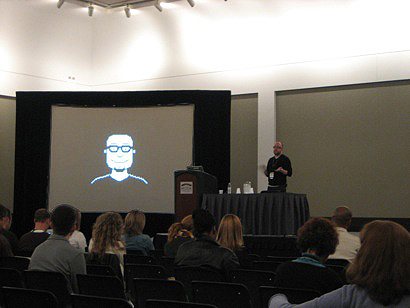
Eric is showing some work by Brian Dougherty at Celery Design Collaborative in Berkely, CA. It’s a eco-friendly light bulb package which is wedge-shaped, instead of the traditional rectilinear box, allowing more packages to take up less space in the box. When you unfold the package, you can turn it into a custom lamp shade. Brilliant.
Eric makes a point of asking for a ceramic mug every time he gets coffee at Starbucks. He says people look at him sideways, as paper cups are stacked high at most counters. He’s living the sustainable life, not only at the studio, but at the coffee shop, home, etc… He doesn’t advocate not being a consumer, in fact, he loves consuming. He just does it with a plan that reduces peripheral waste. Advice to live by that is a change in mindset, but do-able. Good stuff.
Side note: I ran into a friend of mine from back in the day at MASS MoCA, Mike Swaitlowski, who’s also attending the conference and now works as an in-house designer at Hasbro. He was in the Modern Dog session this AM, and said that one question posed to Robynne Raye was, “what are your favorite www sites?” Answer: Robynne said she loves SpeakUp, and checks it everyday. Uh-oh. Sorry I missed your presentation…
. . . . . . . . . . . . . . . . . . . . . . . . . . . . . . . . . . . . . . . . . . . . .
9am
A Designed Life
Speaker: Joe Duffy
Principal and Chairman
Duffy & Partners
Minneapolis, MN
How speaker link
How session link
Joe Duffy’s personal page (bio/info)
Joe Duffy’s blog
Joe Duffy’s www site
Joe Duffy’s AIGA Medalist bio (excellent)
Joe Duffy’s books: Brand Apart (2004)
Choosing this session was tough, as I had to skip Modern Dog Uncensored: Fearless Design with Robynne Raye and Michael Strassburger from Modern Dog, which was scheduled at the same time in a different session. For me, Joe Duffy’s brand work is a bit closer (aspirationally) to the work we do at id29. This is one of the reasons this conference is so well-attended: there are multiple sessions geared towards almost every aspect of the creative, business and technical processes of our industry. Choosing which sessions to attend, in lieu of missing another, however, can be mildly gut wrenching.
Joe Duffy is on stage, showing work and discussing living a “designed life.” I’m familiar with their work, but seeing beautifully done project after project for national brands is impressive, nonetheless.
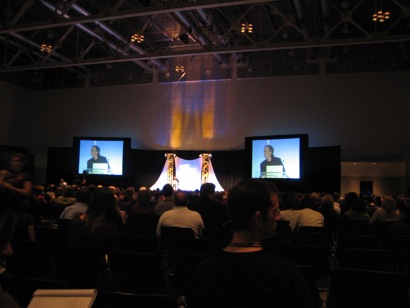
Joe ended his presentation at 10am, and is now taking questions from the audience. A few of the questions are along the lines of, “How do you convince your clients to implicitly trust you?” His responses are very calm and thoughtful, and it’s easy to imagine him leading the largest presentation to any client and putting everyone in the room at ease.
A question was raised about sustainability in design w/r/t packaging design. Good question, as Duffy & Partners is well known for packaging. Joe is talking about how his clients now demand more from less, and want to see a smaller carbon footprint reflected in minimalist packaging solutions.
. . . . . . . . . . . . . . . . . . . . . . . . . . . . . . . . . . . . . . . . . . . . .
7 Questions with Bryn Mooth :: Editor in Chief, How Magazine
. . . . .
Doug Bartow: Bryn, can you give me a bit of history on the How Design Conference since its inception in 1991?
Bryn Mooth: Funny—I was recently looking over some old conference materials from way back. I was an entry-level staffer on the magazine when the conference launched, so I remember the very first one in Miami. Those first few years, we had maybe two dozen speakers and 500 attendees or so. This year, we have 60+ speakers and nearly 4,000 attendees.
We’ve always looked at the conference as a living iteration of the magazine: practical, friendly, helpful, sort of like a mentor. The magazine’s business, creativity and career content really lends itself to a live event. So much so that we’ve now got 4 events under the HOW umbrella.
. . . . .
DB: What would you define as the main goals of the conference?
BM: very top priority is giving designers real-world information that they can take back to their desks and actually use. There are many design-industry events where high-level ideas are shared, but we’ve always tried to offer real take-away info, just like the magazine does. The second priority is connecting the whole design community—from the speakers to the attendees to the vendors.
Personally, that’s what I love most about the event: the connections. I love getting away from my desk and meeting the people that buy and read and use the work that I do.
. . . . .
DB: Other than attendance numbers, how do you define/measure the conference’s success?
BM: Well, the attendance numbers are the most obvious way we measure success. But we also look at the feedback we get from attendees. Were they happy? Did the comments about how people valued their experience outnumber the gripes about stale bagels or whatever? We look at feedback from vendors, too: Were they happy with the interaction they had with attendees?
. . . . .
DB: What criteria do you use to select the presenters and programming?
BM: People might be surprised at how structured our programming process is. In the course of putting together the magazine and publishing HOW Books, we discover a bunch of potential speakers. We contact those folks to see if they’d be interested—and we ask them for speaking references. We look for speakers who’ve presented to large groups before, and we check references to vet all our potential speakers.
We generally have a pretty good idea of the topic we want speakers to address before we invite them. Hopefully, that minimizes the number of dog-and-pony shows that don’t have a lot of take-away info, although we do invite certain speakers to present their body of work and talk about it.
. . . . .
DB: What one thing do you think first-time attendees discover about the conference that they didn’t read about in the pre-show literature or online forums?
BM: I think first-timers are surprised by the size and energy of the group. I’m always amazed by that myself. It’s just so incredibly cool to be in a room with thousands of creative people who really GET what you do and share your passion for your work. You have to be there to understand.
. . . . .
DB: How Conference 2009, have you chosen a venue city yet?
BM: Yep. Stay tuned until Wednesday, when we’ll announce it right before the closing keynote session. I can’t spill the beans before then, but I’ll tell you it’s in my very favorite U.S. city.
(DB: sorry Canada)
. . . . .
DB: Finally, I understand that your grandmother is Dorothy Mengering, aka: Dave Letterman’s mom. Does her sense of humor run in the family?
BM: You’re right: I do have the world’s coolest Grandma. How’d you know?
She’s not laugh-out-loud funny, but her very motherly interactions with my uncle are what’s funny. She’s in her late 80s, and she’s experienced some pretty amazing things in the later part of her life: going to the Olympics (three times), writing a best-selling cookbook, being on TV. She rocks.
. . . . .
DB: Thanks, Bryn. And Congrats!
. . . . . . . . . . . . . . . . . . . . . . . . . . . . . . . . . . . . . . . . . . . . .






I'm having breakfast here right now in the Vendor area, and it seems a hell of a lot less crowded as last night, when people were practically mobbing each other for free t-shirts. Looking out the lobby in the Hynes, all you see are dozens and dozens of bloggers and designers with laptops, typing away on the free wi-fi that the conference provides.
I'm very excited about the Modern dog speech coming up, first thing this morning.
Anybody else here?
On May.19.2008 at 08:40 AM